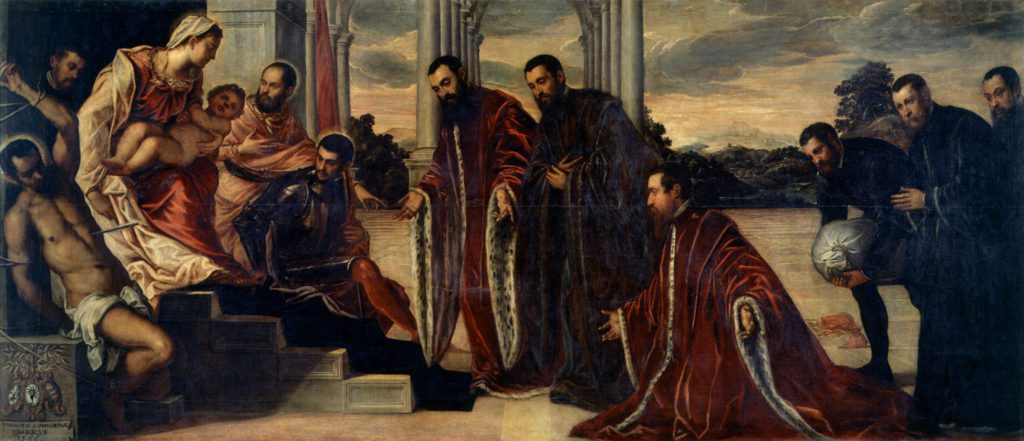Tintoretto: One of History’s Greatest Painters All Along
By • May 1, 2019 0 1194

It is possible that Tintoretto will prove the most essential Renaissance painter for the 21st century. It is also possible that you, like me, will stumble out of this rare and wondrous National Gallery of Art retrospective wondering whether his was the most virtuosic hand to ever wield a brush.
I was astonished by this exhibition. After seeing it last month, New Yorker art critic Peter Schjeldahl wrote that “you can get drunk on Tintoretto.” It’s an appropriate and perhaps instructional metric of enthusiasm; as with heavy drinking, you should consider how much time it might take you to recover.
Although Tintoretto’s story looms throughout untold volumes on the European Renaissance, you won’t know that you don’t know him until you walk through these galleries. Enough praise cannot be given here to exhibition curators Robert Echols and Frederick Ilchman, who chronicled the artist’s life and career so profoundly as to reinvigorate it. Over the past three decades, they have performed almost forensic analysis, undoing centuries of misattributions that suppressed Tintoretto’s reputation.
“Venice is full of stodgy paintings attributed to Tintoretto,” says Echols.
“The bulk of our work over the last 30 years was to clarify what Tintoretto actually painted,tocapturehisindividualpersonality as a painter,” adds Ilchman. “People are confessing to us that they didn’t like Tintoretto until now.”
It turns out that Tintoretto was one of history’s greatest painters all along. But what’s more intriguing is that the quality of his work is shockingly modern.
“Certain things about Tintoretto that were audacious in his time later came to fruition,” says Ilchman. “Large paintings covering whole walls where the technique is a big portion of the content, from Rubens to Pollock— to anticipate that!”
The blunt force of the artist’s talent is on display from his earliest works. Tintoretto was essentially self-taught — another revelation from Echols and Ilchman — training with fresco painters and furniture decorators who worked remarkably fast, forgoing the careful finishing techniques of Venice’s renowned painting workshops.
“He would go anywhere to learn new ways to paint,” says Echols, “even working with low prestige painters, who toiled under the arcades of the Piazza San Marco decorating chests and furniture.”
“The Conversion of Saint Paul,” c. 1544, reveals an inchoate but explosive energy. Wisps and washes of paint dusted lightly with details, it’s a controlled chaos defined by large swaths of color.
A youthful self-portrait of delicious vanity greets you upon arrival — the first of two portraits that bookend the show. The background is void, his shirt an undefined black mass. Light concentrates around his face, from which piercing, sensitive, long- lashed eyes linger beyond the viewer from the shadow of a prominent brow.
Tintoretto was rebuked by his peers for working “too quickly.” His paintings, betraying visible brushstrokes, looked “unfinished.” But it’s precisely this quickness of brush, this “unfinishedness,” that appeals so strongly to us now. By comparison, canvases by Titian and Raphael seem tame and controlled. Tintoretto’s have a roiling, if refined, surface texture, suggesting a certain act of discovery through painting, as though he were creating masterpieces on the fly. Which, it turns out, he was.
A handful of his drawings — as well as a separate exhibition of them just downstairs — offer insights into how the artist worked so quickly, and how he thought about composition and the human form. A reclining male nude ripples with dunes of musculature, a study for “Saint George and the Dragon,” c. 1555, hanging on the opposite wall.
His enormous painted sketch for “Paradiso,” c. 1583, is a masterpiece in itself. “Paradiso” was his largest and most important mural in the Doge’s Palace, a prize commission he had eyed for decades. Christ crowns the Virgin Mary as Queen of Heaven before the ranks of the blessed, a vast congregation of angelic forms receding on clouds into infinite light. It combines the sort of loosely centralized, all-over composition that you scarcely see in Western art before 20th-century abstraction with the narrative grandeur of the Italian Renaissance.
This probably isn’t a piece that would have been displayed widely in his lifetime, but this is our privilege in looking at Tintoretto’s work today. We appreciate loose and textured virtuosity, favoring painting that flaunts the quality of the artist’s hand. “Compositional rhythms and bold color tones applied with energetic gestural brushstrokes” could just as well describe Joan Mitchell as Tintoretto.
From here, the show transforms into a spoil of wonder. “The Origin of the Milky Way,” c. 1577/79, is soaked like a rum cake with lapis lazuli, engulfed in cloths of red and gold, glimmering peacocks and cherubs with wings like exotic birds.
In the final gallery hang two immense canvases from the Scuola Grande di San Rocco, for which Tintoretto painted more than 50 canvases over 24 years. In these later paintings, and toward the end of his life, Tintoretto reorients his compositions around landscape and light, mystical and introspective.
His final self-portrait was painted six years before his death. It’s a far cry from the youthful defiance of his earlier portrait, overcome with a certain fatigue, his sunken cheeks disappearing into a wispy beard. Yet his eyes still radiate with the sensitivity of one who deeply observes the world around him.
Edouard Manet called it “one of the most beautiful paintings in the world.” He could have said that about anything by Tintoretto, and who among us would be foolish enough to disagree?

